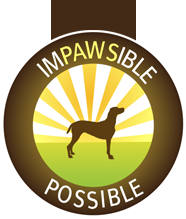HELP! I AM LOST
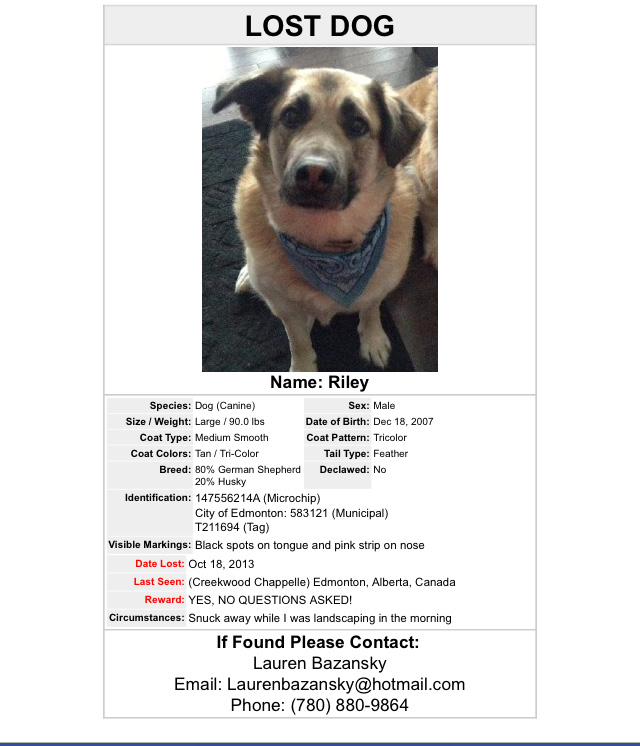 How to (Successfully) Introduce a New Dog Into Your Home
How to (Successfully) Introduce a New Dog Into Your Home
By Shandell Van Hell on October 10, 2013
So you’ve taken the plunge and decided to adopt another dog for your family.
While you and your new dog (let’s call him Fido) may be instant best friends, Fido and your resident dog (let’s call him Buddy) may need a bit more time to get to know one another before they’re completely sure of one another.
New friendships take time and understanding, dog friendships included. To help ease Buddy into the idea of him not being an ‘only dog’, we have compiled some helpful suggestions for bringing Fido home.
Choose a good time to bring Fido home: Vacation time is a great time to add a new animal to your family! No, we’re not talking that kind of vacation, we’re talking more of the stay-cation types. Adopting an animal during your time off allows you to get to know the animals and make the transition easier for all involved. Supervision, exercise and some good ol’ fashioned snuggle time on the couch make the first couple of days easier for everyone. Long weekends that you’re sticking around for are also excellent for adding a new family member.
Choose a neutral location: We all have that one friend who brought their new dog home, opened the door and BAM: the new dog and the old dog were instant best friends. But more often than not, dogs need a bit more help than that. While Buddy may be a super social guy who loves every dog he meets at the park, this is different. This is his house, his stuff and his people. Introducing dogs in a neutral location helps Buddy to see Fido as a friend rather than a territory intruder. Each dog should be handled by a separate handler. With both dogs on a loose leash, take them to an unfamiliar area like a park or green space.
Remain calm: This is definitely easier said than done, especially if you’re a bit nervous. Make a conscious effort to remain relaxed and keep a loose leash. Walk the dogs towards one another with as loose a leash as possible and step away if you notice the dogs tensing up and try again. It may take a couple tries to ensure everyone is comfortable. Also, approach one another on an arc from the side – straight on is intimidating for dogs!
Use positive reinforcement: From the first meeting, you want both dogs to expect ‘good things’ to happen when they’re together. Let them sniff one another – this is normal dog behavior! Talk to them in a happy, friendly tone of voice. Try to avoid using an aggressive or threatening tone. Once the dogs have met and sniffed take them for a walk letting them interact with their environment and one another. Continue with ‘happy talk’, food rewards and simple commands.
Be aware of body posture: One of the best indicators that things are going well is a ‘play bow’. One dog will crouch with his front legs on the ground and his hind end in the air – the doggy version of downward dog! This is an invitation to play and will usually elicits friendly behavior from the other dogs. Dogs use calming signals to communicate with one another and humans. Watch for postures that indicate aggressive response including the hair raising on the other dogs back, teeth baring, deep growls, stiff legged gait or prolonged stares. Simply interrupt these interactions by calming and positively getting the dogs interested in something else: get them to sit, offer a treat, look at something else. Diverting their attention will stop the situation from escalating into aggression. Allow the dogs to interact again for a lesser time or with more space.
Taking Fido and Buddy home: When the dogs seem to be tolerating each other’s presence without fearful or aggressive response and the investigative behaviors have tapered off, its home time! Don’t put your dogs in a position to make a mistake. Control and supervise the new dog until both dogs are calm with each other. We wish we could give you a time frame, but each dog is different. This could range from a couple minutes to a couple weeks or even months. Fido may settle in quickly or take several months to adjust – continued positive reinforcement, supervision and separation are key.
Special time for each dog: Ensure each of your dog’s gets some special alone time with you. This could mean playtime with Fido in the backyard, while Buddy enjoys a tasty bone.
Multiple dogs: Have more than one resident dog? Introducing one dog at a time is advised as more than one can often overwhelm the newcomer.
Introducing puppies: Ah, puppies. So cute, but boy do they know how to push adult dogs buttons! Before four months of age, puppies do not usually recognize subtle body postures from adult dogs signaling they’ve had enough. Well socialized adult dogs with good temperaments may set limits with puppies with a growl or snarl. This is normal! Less socialized adult dogs may use a more aggressive approach (biting for example) and should not be left alone with the puppy.
When to get help: Is the introduction of Buddy and Fido not going as smoothly as you had hoped? Don’t panic. Dogs sometimes need time and space to adjust. Contacting a professional trainer is a great solution. If the dogs are fighting get help immediately. Dogs can be severely injured in fights and the longer the problem continues, the harder it is to resolve.
Exercising Fido
But we have some other suggestions when it comes to exercising your dog. You’ll find these especially helpful when its -30 outside and Fido needs some exercise.
- Fetch. The most obvious suggestion. Toss a ball across the room or yard. Let you dog, wait for it, fetch it! Remember, a 10 foot throw means 20 feet of running for Fido. Excellent. If Fido doesn’t drop it when he comes back, use a second, equally interesting toy and throw that for him. At the beginning it is not necessary for your dog to drop the first toy. What is more important is that your dog does not learn to run away or not drop it for you.
- Up & Downs. Stand at the top of the stairs or a hill in a safe dog friendly area and toss a ball down. Encourage Fido to retrieve it. Consider this Fetch 2.0.
- High Jump. All you need is a carton or overturned chair and some encouragement for your dog to jump over. Raise the height as your dog becomes more limber.
- Use doors and gates. Have your dog sit every time you open a door. Think of the number of times you open and shut a door during the day. Fido will be tired and good at sit. That’s a win-win.
- “FIDO!” Coming when called is great exercise, especially if you have your dog running back and forth between two people.
- Name toys. Name your dog’s different toys. No need to get creative – a stuffed critter can be called ‘critter’ and a ball can be called ‘ball’. Tell Fido to get ‘critter’ while pointing at critter. When Fido seems to understand the game tell him to ‘Go get critter’. If he gets ‘critter’, praise and play with your dog using the toy. If he gets the wrong toy, ignore him and go get the right toy with him. Once Fido is skilled at this game, you can start hiding the toys to make the hunting experience more difficult and stimulating.
- Tricks. Dog tricks are fun for people and dogs. They’re also good to impress your friends with at parties.
Dealing with Puppy Nipping & Rough Behaviour
They’re adorable, cuddly and have such fun personalities!
They can also make you want to tear your hair out a little bit (okay, a lot) with their nipping and rough play.
Don’t worry, you’re not alone in this.
Bite inhibition is a learned behavior, so it’s only natural that you – their human – seems like a great place to test the limits. The goal is to redirect your puppy’s desire to put something in their mouth (like your arm or pant leg) onto something good like a chew toy. Puppies need to be taught that human skin is never acceptable. When puppies play with each other they can learn bite inhibition and proper social skills with other dogs.
Encourage Acceptable Behaviour: Redirect your puppies need for biting and nipping by offering more acceptable objects like chew toys whenever you pet Fido. As you reach out to scratch behind Fido’s ear, offer the chew toy in the other.
Discourage Unacceptable Behaviour: Teach Fido that nipping ‘turns off’ any attention and social interaction with you. As soon as the nip occurs and yell ‘OUCH’ – it’s time to be a drama queen. Ignore Fido until he’s calm and then try the petting/chew toy method outlined above again. Another option is to get up and walk away, leaving the room and even shutting the door. Never use physical punishment (like slapping a puppy under the chin or forcefully holding his mouth closed) that involves some level of discomfort or pain because it may end up in a bite.
When Fido jumps up, you are giving her the attention she wants by pushing her off or telling her to get off. Instead try these helpful tips:
- Completely ignore him. Turn your back to Fido without making eye contact.
- Continue to ignore Fido until all four paws are on the ground, quietly praise her and then give him a treat.
- If Fido begins to jump while you’re praising him, simply turn away and repeat the above steps. It may take a couple times to get your point across. Keep your praise low key and consistent.
- Ensure you don’t ignore her when she comes and sits politely waiting for your attention.
Don’t use physical punishment against your puppy – just don’t do it! Attempts to tap, slap or hit your puppy in the face for nipping or jumping should never be used. Several things may happen, depending on your puppy’s temperament and the severity of the correction:
- Become hand shy and cringe or cower whenever your hand comes towards his head.
- Become afraid of you and refuse to come up to you or approach you at all.
- Respond in a defensive manner and attempt to bite you to defend himself.
- Interpret a mild slap as an invitation to play, causing her to become more excited and more likely to nip.
D.I.N.O is pleased to offer 6 weeks of Pet Secure Insurance with their adoptions. DNA kits to adopters, Discounted Training through CAT, earth options dog food, grooming ($30) and boarding is also available for purchase.Boarding, for $20 per day, is also offered by DINO Rescue. Preference will be given first to our adopters, but we will happily accommodate others if space allows.Please contact us for further information on our boarding! Thank you from the DINO Rescue team!
DNA My Dog Canine Genetic Testing
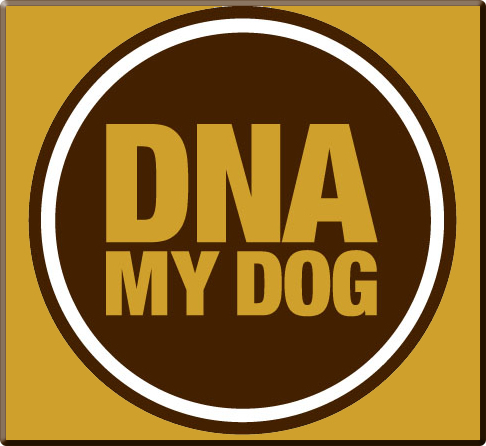 Your dog’s unique DNA – Only $10
Your dog’s unique DNA – Only $10
DNA My Dog’s simple cheek swab DNA test lets you learn every breed in your dog and gain insight into the unique genetic background of your dog including the history of their breed, personality traits, exercise levels, and so much more!
Every dog has its own unique DNA. DNA My Dog provides you with a kit and very simple instructions for swabbing the cheeks of your dog and collecting your dog’s DNA samples. The test is easy, painless and takes under a minute.
Impawsible – Possible
Urban Freedom Calgary: ***For dog & human friendly dogs only*** Class limited to 6 dogs!!!
Pre-requisite: None except dog must be human & dog friendly
Class Description: Are you embarrassed by your dog’s behaviours and bad manners? Does he run in the opposite direction when you call him? Does he pull you down the street on your walks, leaving you in puddles of spilt lattes? Does she struggle to find focus in the urban environment amidst the myriad of distractions. If you answered “yes” to any (or all) of these questions then Urban Freedom is for you. Transform your dog into an ideal urban citizen, this fun and educational program
Number of Classes: Urban Freedom Calgary consists of 14 Classes over the course of 7 weeks at 14 unique outdoor locations in Calgary (each class is 1 hour)
Tuition: Regular: $289 + GST DINO Rescue: $231.20 + GST (Save 20%)
Feisty Fido: ***For dogs with fears, aggression, reactivity and/or anxiety *** Class limited to 5 dogs!!!
Pre-requisite: None
Class Description: Does your dog make embarrassing displays at the end of her leash? Does she lunge, bark, snarl and growl at dogs, strangers, skateboards, cars, bikes or even snowmen? If you dread leaving your house with Fido for fear of what, or whom, you may run into then this class is for you. In this 6 week class dedicated to Feisty Fidos, you will learn everything you need to know to manage and permanently modify these undesirable behaviors so that you can leave your house with confidence – looking forward to whatever “challenges” are lurking around the next corner.
Number of Classes: 6 Classes (First Class is Human only orientation)
Tuition: Regular: $289 + GST DINO Rescue: $231.20 + GST (Save 20%)
Recipe of the Month 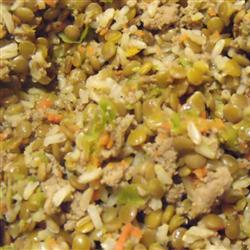
1 teaspoon dried rosemary
1/2 (16 ounce) package frozen broccoli, carrots and cauliflower combination
Directions
- Place the water, ground turkey, rice, and rosemary into a large Dutch oven. Stir until the ground turkey is broken up and evenly distributed throughout the mixture; bring to a boil over high heat, then reduce heat to low and simmer for 20 minutes. Add the frozen vegetables, and cook for an additional 5 minutes. Remove from heat and cool. Refrigerate until using.
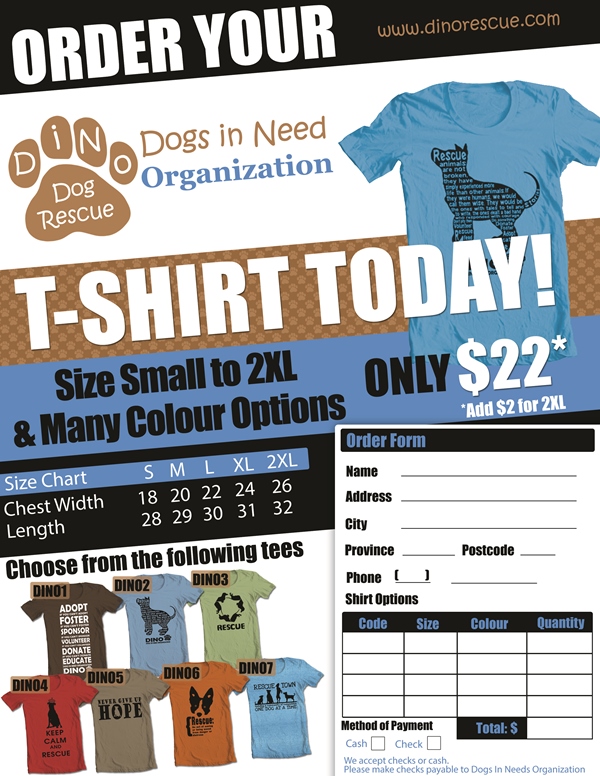
8 Foods You Should Never Give Your Pets Cont’d
7. Avocados
The avocado tree leaves, pits, fruit and plant bark are likely all toxic. Clinical signs in dogs and cats include vomiting and diarrhea.
Dog Nutrition Cont’d
How Much and Often to Feed
Most dogs love to eat and eat. Even though it’s tempting to show your love with extra helpings, or by making food available all day, overfeeding does no dog any favors. Overweight dogs can suffer from the same ailments as overweight humans do. There is no precise answer as far as how much to feed a dog-because caloric needs vary with size, age, and activity level. How often should you feed your dog? Morning and evening meals are recommended for adult dogs. (Puppies are different-follow your vet’s advice.) Twice daily feedings make it easy to monitor your dog’s intake, and thus his health, since dogs who are not feeling well tend to drop their routines. Also, regular feedings keep a dog…regular.
NEEDED
D.I.N.O. Rescue is seeking temporary loving homes for rescued dogs so that our pups can get back on track as soon as possible with a love filled life. Our foster homes are an incredibly important part of our organization and if you are interested in opening your home and heart to one of our pups we’d be very appreciative. Fostering is the perfect way to experience having a pet without the financial burden so if you’d like to take a dog in please fill out our foster application form here —>
https://dinorescue.org/fostering/Dogs of the Month
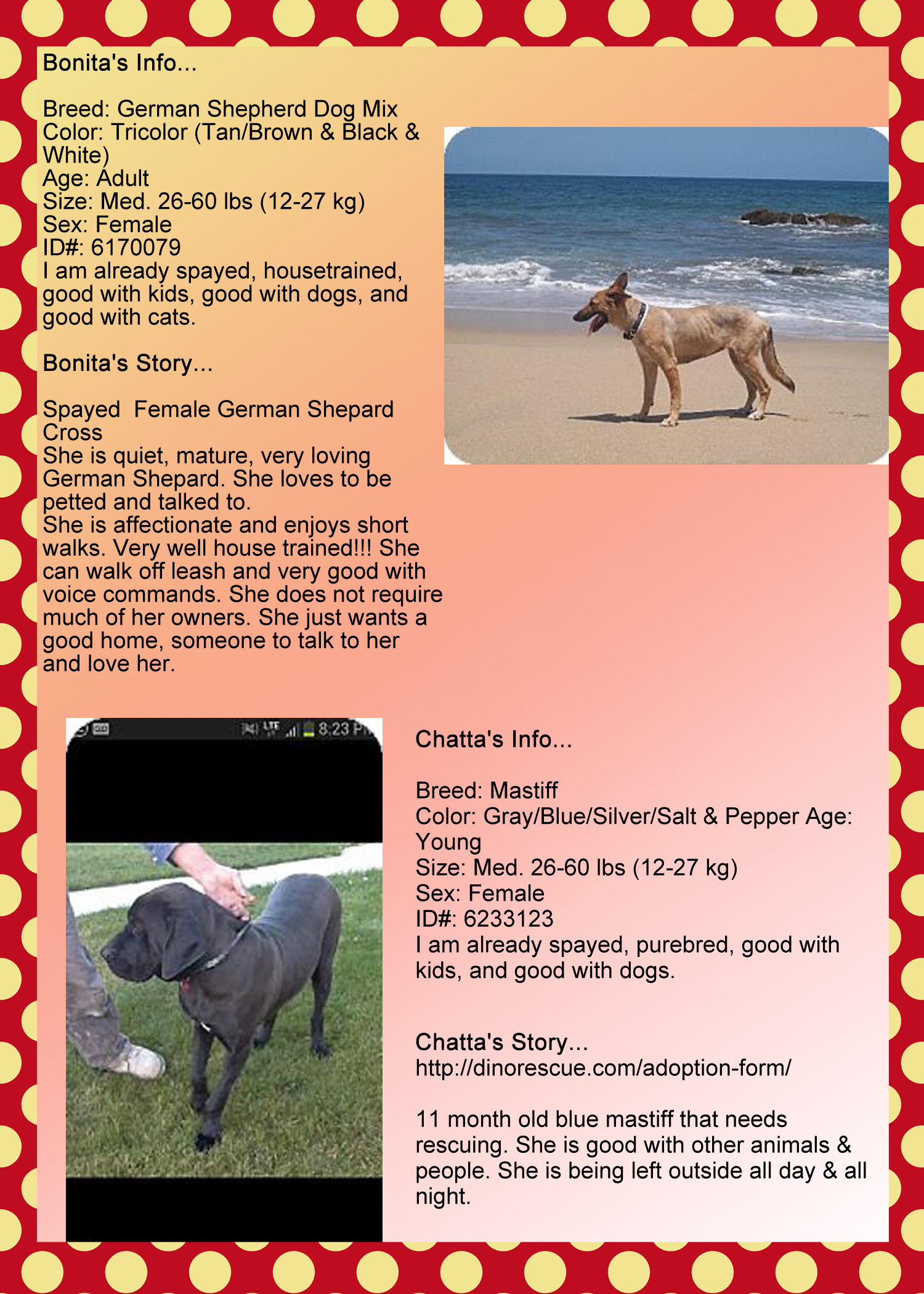
Do I Go Home Today?
By Sandi Thompson ~
My family brought me home cradled in their arms. They cuddled me and smiled at me, and said I was full of charm.
They played with me and laughed with me, they showered me with toys. I sure do love my family especially the girls and boys.
The children loved to feed me, they gave me special treats. They even let me sleep with them all snuggled in the sheets.
I used to go for walks, often several times a day. They even fought to hold my leash, I’m very proud to say.
These are things I’ll never forget a cherished memory. I now live in a shelter without my family.
They used to laugh and praise me when I played with that old shoe. But I didn’t know the difference between the old ones and the new.
The kids and I would grab a rag for hours we would tug. So I thought I did the right thing when I chewed the bathroom rug.
They said that I was out of control, and would have to live outside. This I did not understand although I tried and tried.
The walks stopped, one by one; they said they hadn’t time. I wish that I could change things, I wish I knew my crime.
My life became so lonely, in the back yard on a chain. I barked and barked all day long to keep from going insane.
So they brought me to the shelter but were embarrassed to say why. They said I caused an allergy, and then, kissed me goodbye.
If I’d only had some classes, as a little pup I wouldn’t have been so hard to handle when I was all grown up.
“You only have one day left,” I heard the worker say. Does this mean a second chance? Do I go home today?

 How to (Successfully) Introduce a New Dog Into Your Home
How to (Successfully) Introduce a New Dog Into Your Home
 Your dog’s unique DNA – Only $10
Your dog’s unique DNA – Only $10